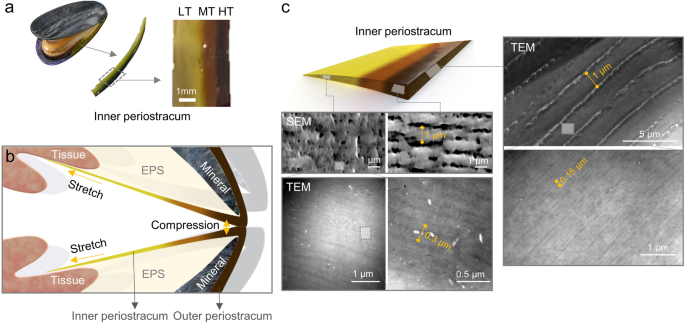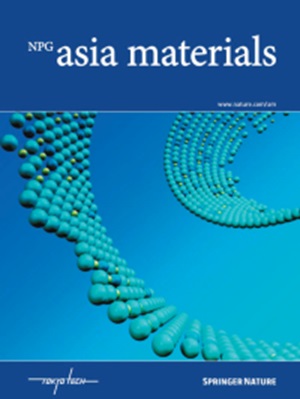作为软组织与硬质材料界面的粘弹性-孔凝胶分级材料--贻贝骨膜的研究
IF 8.3
2区 材料科学
Q1 MATERIALS SCIENCE, MULTIDISCIPLINARY
引用次数: 0
摘要
贻贝骨膜是一种非生物多功能凝胶,覆盖在贻贝坚硬的无机外壳上,可在恶劣的海洋环境中提供保护,防止机械撞击、生物污染和腐蚀。从生物组织中产生的包膜内部是组织与无机材料之间的天然界面。骨膜在提供界面的植入式设备中显示出巨大的应用潜力,但这一系统仍未被开发。在这项研究中,我们发现内骨膜具有分级机械功能,并能有效消散能量,以适应两侧刚度和应力类型的差异。在组织端,轻度色素沉着的骨膜在重复张力作用下表现出伸展性和能量耗散性。这一过程得益于已发现的主要蛋白质(我们将其命名为包膜蛋白)中β-链的滑动和重新组合。在壳的一端,高度色素化、矿化和多孔的壳周膜部分提供了硬度,并缓冲了壳门在闭合过程中施加的压缩应力。这些发现为设计连接人体组织和设备的界面提供了新的可能性。本文章由计算机程序翻译,如有差异,请以英文原文为准。


Investigation on mussel periostracum, a viscoelastic-to-poro-gel graded material, as an interface between soft tissue and rigid materials
Mussel periostracum, a nonliving multifunctional gel that covers the rigid inorganic shells of mussels, provides protection against mechanical impacts, biofouling, and corrosion in harsh ocean environments. The inner part of the periostracum, which emerges from biological tissues, functions as a natural interface between tissue and inorganic materials. The periostracum shows significant potential for application in implantable devices that provide interfaces; however, this system remains unexplored. In this study, we revealed that the inner periostracum performs graded mechanical functions and efficiently dissipates energy to accommodate differences in stiffness and stress types on both sides. On the tissue end, the lightly pigmented periostracum exhibits extensibility and energy dissipation under repetitive tension. This process was facilitated by the slipping and reassembly of β-strands in the discovered major proteins, which we named periostracin proteins. On the shell end, the highly pigmented, mineralized, and porous segment of the periostracum provided stiffness and cushioned against compressive stresses exerted by the shell valves during closure. These findings offer a novel possibilities for the design of interfaces that bridge human tissue and devices. The interfaces linking biological tissues and man-made devices is challenging due to mechanical mismatch, biofouling, and water content. Soft materials such as hydrogels have emerged in diverse applications, however, their unresolved problem is the loss of functions in a short period. This report explores natural connective tissue, called periostracum, which is perfectly bridged between biological tissue and inorganic nonliving shell with high durability for long-lasting functions. Its hierarchically designed strategy provides a novel blueprint to design durable soft materials for the interfacing device into tissue.
求助全文
通过发布文献求助,成功后即可免费获取论文全文。
去求助
来源期刊

Npg Asia Materials
MATERIALS SCIENCE, MULTIDISCIPLINARY-
CiteScore
15.40
自引率
1.00%
发文量
87
审稿时长
2 months
期刊介绍:
NPG Asia Materials is an open access, international journal that publishes peer-reviewed review and primary research articles in the field of materials sciences. The journal has a global outlook and reach, with a base in the Asia-Pacific region to reflect the significant and growing output of materials research from this area. The target audience for NPG Asia Materials is scientists and researchers involved in materials research, covering a wide range of disciplines including physical and chemical sciences, biotechnology, and nanotechnology. The journal particularly welcomes high-quality articles from rapidly advancing areas that bridge the gap between materials science and engineering, as well as the classical disciplines of physics, chemistry, and biology. NPG Asia Materials is abstracted/indexed in Journal Citation Reports/Science Edition Web of Knowledge, Google Scholar, Chemical Abstract Services, Scopus, Ulrichsweb (ProQuest), and Scirus.
 求助内容:
求助内容: 应助结果提醒方式:
应助结果提醒方式:


